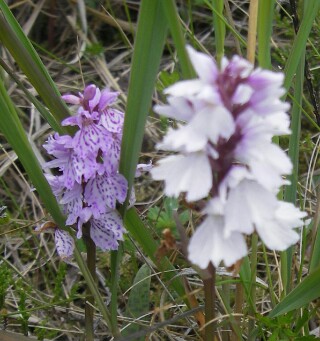Day 57 Wed July 11 Isle of Rum

As we had booked for an eagle spotting walk at 0930 we had to be ashore in time to walk to Kinloch Castle for a prompt start. This time we used the outboard on the dinghy, which meant we could move more easily and further up the Loch to a large jetty, where we tied upand walked along the path, via a small, perfectly clean and useable, brick sh**house. Our party of a dozen Malts sailors was met by our guide, a naturalist with Scottish Natural Heritage, who now own the island on trust, and we set off along the track up the glen to learn about and hopefully see some of the flora and fauna of the island. Rum had been part of the provice of the Lords of the Isles, first Norse and then Celts, but following the Highland Clearances in the early 19th Century, the isle was owned by first by the Marquis of Salisbury and then by Sir John Burroughs, a wealthy Lancastrian industrialist, populated with deer and run as a hunting estate. On his death the island pased to his son Edward, who set about building Kinloch Castle, a magnificent country house and estate with a commanding view down Loch Snesort. Ian and I returned to tour the castle later (see below). Our two hour walk was most rewarding. We did not see the rare sea eagles, but did see a golden eagle soaring over the mountain top, mobbed by a kestral, the unique Rum ponies, and roe deer grazing further up the glen. The flora we saw included common spotted orchids and a rare Rum orchid, sundew insectivorous plants, bog asphadel, cotton grass and many others, too much for us to remember! We were mercifully spared midge bites, partly because we had each liberally applied our favourite repellent (Avon Skin So Soft for me) but mainly because the cold summer and brisk winds had kept the blighters at bay more than usual. After a short stop for a drink at the village hall/shop/post office David went off to hire a bike to explore the island, and Ian and Benj returned for a bacon buttie while awaiting the castle tour start at 1330. There were about a dozen on the tour, most having come for the day by ferry. The 'castle' - really more of a large baronial style country house - was built in the late 19th century as a huntin' shootin' and fishin' lodge, used for only a few weeks during The Season, but with a permanent staff of about 100. The large entrance hall is hung with more stag's heads than you could shake a big stick at, enormous stuffed fishes, portraits of the Burroughs, including a fine one of Lady Monica. There are many stories about how Edward won his Baronetcy, including acting as a witness in divorce proceedings in order to save the reputation of the Prince of Wales. The room is dominated by an enormous bronze eagle attacking monkeys, possibly a gift from the Emperor of Japan, and on the gallery two cloisonne work chinese vases more than 6 feet high. A unique feature is the Orchestrion, built in under the stairs, which our guide demonstrated. Like the smaller versions sometimes seen in travelling fairs, it is driven by perforated paper rolls, producing impressively loud music through numerous organ pipes, with an array of percussion effects. This is one of only two surviving models of its kind, built by a German family company, and the house has up to 40 rolls, though they have not all been tested since the refurbishment of the castle started. The tour continued through the bedchambers, some equipped with an en-suite bath/shower powered by an impressive array of tubes, taps, and shower heads designed to spray the user in all directions. The smoking room/billiard room has an early air conditioning/heating system, and this was the second home in Scotland (after Glasgow) to have electric lighting. The ballroom has (of course) a sprung wooden floor, a player piano and a minstrel's gallery. An interesting feature is the dining room, which has seating for 16, because the table and chairs came from the stateroom of Sir Edward's 261 ft Steam Yacht Rhuama. Each chair has a hole in the centre of the base, which was fixed to the cabin sole when they were on board, and could swivel to allow access. The yacht was loaned to the nation during the Boer War as a hospital ship and on display was a log of the patients detailed, name and rank and condition treated: this is the 'official' explanation for how the industrialist gained his knighthood. The game record book was also displayed, showing that on some weeks a stag or more was stalked and shot every day, by gemtlemen and ladies. Altogether a fascinating tour, and a glimpse of the gentry lived less that 100 years ago.
Ian and Benj returned to the boat and later David hailed us from the shore, his ride to the further reaches of the island completed, some 26k uphill and down dale, in time for Evening Prayers followed by supper of pasta and red wine, and yet another spectacular Hebridean sunset.






